
- Formation of Natural Pearl
- Color Varieties of Pearl
- Sources of Natural Pearl
- Trade Names and Types of Pearls
- Shapes of Pearls
- Physical & Optical Properties of Pearl
- Care for Pearls
- Valuation and Buying Tips for Pearls
Introduction

Because they do not requires any kind of fashioning to reveal their incomparable loveliness, natural pearls have been cherished from the earliest times of mankind. His search for food along the seashores and rivers led primitive man to the discovery of pearls in the earliest days of his emergence as a reasoning being; today, they are still among man's most prized possessions. It is safe to say that no object used for purposes of personal adornment has held its position of relative desirability for so long a period.
Pearl is mentioned in the book of Job and in the Talmud. The later Egyptians, Persians and Hindus held the natural pearl in great esteem, and through them the Romans became acquainted with it. Historians tell us that pearl was the favorite gem of the men and women of the Roman period, and that they attempted to outdo one another in their lavish use of them as articles of adornment. Couches and trappings fairly shone with the splendor of the pearl. Roman women even wore them in their sleep, so that the presence of the gems would remind them of their wealth in moments of awakening.
Natural Pearls that have become famous because of their unusual size and beauty are few in number, principally because maximum beauty is seldom encountered in the largest natural pearls and the size of any pearl is limited to the size of the mollusc in which it grew. Thus, the order of magnitude by which the extreme exceeds the usual large pearl is not great. This statement applies to regular shapes of whole pearls, not to very irregular masses or to those that are attached to the shell, for these may constitute most of one valve of the shell. In contrast to may of the famous diamonds of the world, most of the natural pearls mentioned in antiquity have lost their identity or have been destroyed. Others, however, are still intact and are the prized possessions of museums or private collections.
One of the largest salt / sea water pearls in existence is the Hope Pearl, first acquire in the early part of the last century by a London banker, Henry Philip Hope, and now displayed in the British Museum of Natural History. This remarkable specimen, however, is not spherical. It weighs 1800 grains, is two inches long and four and one half inches in circumference at its broadest part, and three and one fourth inches in circumference at the narrowest end. Perhaps the finest fresh-water pearl known is the Queen Pearl. It is round, translucent and weights 93 grains. It was found near Paterson, New Jersey, in 1857 and was later sold to the Empress Eugenie. La Pellegrina, renowned as one of the world's loveliest Oriental Pearls, is round and weighs 111 1/2 grains. It now reposes in the Museum of Zozima in Moscow. An 1191 grain tear-drop-shaped pearl called "The Miracle of the Sea" is presently owned by the Imperial Pearl Syndicate. It has formerly in the crown jewels of the Emperor of China.
No royal treasury is without quantities of pearls designed for wear in necklaces and many other forms of jewelry. The treasury of the Gaekwad of Baroda, for example, contains a sash composed of one hundred lows of pearls, seven strands of pearls valued at nearly one million dollars, a litter set with thousand of seed pearls, and a carpet of pearls ten and one-half feet long and six feet wide. This carpet-is believed to be the most costly ornament in the world, with an estimated value of several millions of dollars.
Derivation Of Names
Several words have been associated with pearls that can be traced through a number of languages. Zoologists chose these words as names for some of the important genera of molluscs that produce pearls. The Greek world for pearl, "margarita," is thought to have been derived from either the Babylonian word meaning "child of the sea" which in turn came from a Persian word through the Sanskrit, or from one of the other Eastern languages, most of which had words of the same root. It is from this source that our names Margaret and Margaret and Marguerite are derived. The word pearl in English, as well as comparable words in German, French, Italian, Spanish and other modern languages, comes from the Latin word "Perula." Other Roman names such as "Unio" and " Pina" are applied to some of the genera names for pearl-producing molluscs.
The Nature of Pearl
Gem pearls have been found in a variety of molluscs. The major pearl-bearing species of the most important genus have been known by various names, including MELEAGRINA, MARGARITIFERA, PTERIA and PINCTADA: the name Pinctada is preferred in current usage. Salt water, or Oriental, pearls are produced by four major species of the Pinctada genus, listed in order of decreasing shell size:
- PINCTADA MAXIMA
- PINCTADA MARGARITIFERA
- PINCTADA VULGARIS
- PINCTADA MARTENS
The last named is the small oyster that is cultivated in great numbers in Southern Japan for use in the production of cultured pearls. Prior to the advent of spherical cultured pearls, however, Pinctada Martens had been a major source of natural pearls. The major Oriental pearl-producing areas have one or more varieties of Vulgaris and/or Margaritifera, the most important species.
The pearl-bearing oysters are not those regarded as edible in the Western world; in fact, gem pearls have never been found in our edible oysters. The only value to edible-oyster concretions is that accruing to the dental profession through an increase in business. In contrast to the oysters that are the chief supply of salt-water pearls, the major source of fresh-water pearls is the mussel, or clam, of the genus UNIO, Various species of the Unio are found in rivers throughout the world, a number of which produce attractive pearls. Pear like objects are found in many molluscs and other invertebrates, but very few have the iridescent sub-found in edible salt-water clams are also lusterless and without value for gem purposes. ABALONES produce pearls with some iridescence, and, although most of them are misshapen, they usually are vividly colored. Pink concretions found in the CONCH (pronounced KONK) lack barnacle and thus cannot be classed as pearls, although they are sometimes set in jewelry. Many people find their soft, pink color attractive; the white or yellowish porcelain like concretions of the conch are far less desirable.
The Pinctada mollusc is enclosed within two hinged shells or valves, of about equal size. Usually, the lower shell becomes attached to some object and only the upper one opens and closes. It is controlled by a pair of strong muscles, the ADDUCTORS. The main portion of the body is separated from the shells by the MANTLE, a protective, tent like membrane that is ore or less folded within the shell to form two flaps. Figure 1 shows the vertical cross section of the mollusc; Figure 2, the horizontal. The outer layer of the mantle, which is in contact with the valves, contains cells that secrete the several different materials of which the shell and nacre are composed.
These cells, which are called EPITHELIUM (pronounced ep-uh-THEE-Iee-um lee-urn) cells, secrete calcium carbonate in anyone of three forms; coarse calcite prisms; coarse aragonite (pronounced ah-RAG-oh-nite) prisms; and tiny, irregular plates made up of a multitude of minute, flattened aragonite prisms. They also secrete CONCHIOLIN (pronounced kon-Kl -oh-Itn), an organic substance comparable to a tough plastic that acts as a cement to bind the carbonate crystal together; it also acts as a protective coating for the exterior of the shell. Only those cells at the a outer edge of the mantle produce the touch conchiolin exterior and the coarse prismatic crystals that form the main body of the shell. In this way, the shell grows outwardly; once formed, this part of the shell never changes.
In the mean time, the remaining cells that cover the mantle deposit iridescent layers of MOTHER-Of-PEARL on the inner walls of the shells and MCRE on the pearls. (These iridescent layers are called mother-of-pearl when they occur on shell and nacre when they occur on the pearl).
The shell in cross section consists of an outer layer of horny conchiolin (Figure 2a), known as the PERIOSTRACUM (pronounced pear-ee-AHS-tray -oum), followed by a prismatic calcite or aragonite section of somewhat greater thickness (Figure 2b), and finally by an even thicker inner section made up of a multitude of mother-of-pearl layers (Figure 2c). Each of these main sections of the shell within the tough conchiolin exterior actually consists of layers of crystals separated by an excess of conchiolin exterior. A fourth layer of prismatic crystals, called the HYPOSTRACUM (Pronounced hyPOS-tray-cum), is located on the inner wall but is confined to the area near the hinge (Figure 2e).
The Cause of Natural Pearl Formation

Our forebears had some fascinating theories for the formation of natural pearls. For example, early in recorded history the belief was held that a drop of dew falling into the sea was caught by an open mollusc and formed into a pearl. When the weather was good, a dark and less attractive pearl resulted. Later, as science began to develop, more realistic theories evolved. In 1554, for example, an investigator named Rowdelet voiced the belief that a pearl was a gallstone.
A half century later, Anselmus de Boot reasoned that the resemblance between the interior of the shell and the surface of the pearl indicated that the shell held fluid that was generated by the shellfish and retained to form a natural pearl. In 1671, a scientist named Redi expressed the belief that a grain of sand that worked its way into the shell was responsible. Shortly thereafter, another researcher declared that undischarged eggs of the mollusc were responsible. In the 19th century, a number of investigators cut pearls in half in order to study their interiors, and found parasites, parasite eggs and a variety of other objects, both organic and inorganic.
In 1904, Boutane, a French scientist, came to the conclusion that if a parasite worked its way into a shell and into the mantle, part of the mantle would separate and become a pearl. Boutane was close to the truth. Sub-sequent research into the part played by the epithelium cells in the construction of the shell and the similarity of structure, luster and iridescence between pearls and the innermost layers of the shell served to clarify the growth of pearls. If an irritant lodges between the shell and the mantle, it causes an indentation, accompanied by increased epithelial-cell development.
Just as is shown in Figure 3, the usual tendency is for the epithelium cells to surround the irritant and to begin to deposit nacre around it. If the irritant is so enclosed early in the life of the mollusc, the pearl may reach a size that depends on the size of the mollusc in which it forms and the temperature of the water in which the animal lives. In the relatively cool Japanese waters, nacre accretion process at a rate of about 15 millimeter radius annually in the small Pinctada Martensii. In the warmer waters near the equator, accretion may assume a pace at least twenty times faster.
Figure 4 shows what would have happened had the irritant become attached to the shell rather than to the mantle: it would have caused the formation of a BLISTER PEARL. This series of illustrations shows the gradual deposition of nacre on the irritant surrounding the shell, forming a protrusion on the surface of the shell that occasionally may assume a rather hemispherical shape.
Structural Characteristics of Pearls
In a round pearl, the layers of substance deposited by the bivalve are arranged concentrically about the nucleus. Figure 5 indicates the arrangement but not the great number of layers composing a pearl. These layers may correspond with any or all of the shell layers; they may consist almost entirely of nacre, of calcite or aragonite prisms, or a combination of all three. However unless at least the outer layers consist of nacre, the concretion is not considered a pearl. Figure 6 illustrates a magnified surface view of the irregular positioning of the over lapping crystals, or plates, comprising the nacre that gives rise to the diffraction and interference of light that results in iridescence. Figure 7 illustrates a cross section of a nacreous layer. Differences in numbers and thicknesses of the nacreous layers are responsible for the different qualities of iridescence and translucency of pearls. As a general rule, the greater the number of nacreous layers below the surface the better the pearl. The only difference in non-gem-producing molluscs (e.g., edible oysters) is that the epithelium cells are not capable of producing the semi-transparent, flattened aragonite crystals that are necessary for the formation of mother-of-pearl or nacre. Instead, their activity is confined to the production of coarse calcite and aragonite prisms and conchiolin.
Color Varieties of Pearls

The color of the majority of natural pearls is the result of two separate components: BODY (or BACKGROUND) COLOR and OVERTONE. When present, the overtone will be superimposed on the body color. The body color is most easily distinguished from the overtone when the pearl is examined under a soft, diffused light. The overtone is seen in the actual reflection of the light source from the surface of the pearl, and the remainder of the pearl shows the body color. Overtone colors include rose (a rose color but pronounced ro-ZAY), blue and green, listed in the order of desirability.
On the basis of body color, pearls can be classified into three major groups:
I. Light Color
In this group are pearls with pink, white or cream body colors. They are further divided as follows:
- Pink - Those pearls that have a pink body color with no overtone.
- Pink Rose - Pearls having a pink body color with a rose colored overtone which often is accompanied by blue or green overtones as well.
- White - Those pearls that have a white or very nearly white body color and no pronounced overtone, but instead have a faint cast or tint of pink, grey or blue.
- White Rose - This term is applied to pearls that have a white or nearly white body color and a rose colored overtone.
- Cream - Pearls having a light-medium-or dark-cream body color with no overtone. Light cream is approximately the the equivalent of very light yellow of low intensity (yellow-brown); dark cream is approximately the equivalent of medium yellow-brown.
- Cream Rose - This term describes those pearls that exhibit a cream body color and a rose colored overtone. The cream body color may be light, medium or dark, and the variations are described as light-cream rose, medium-cream rose and dark cream rose. Cream rose pearls are much and more valuable than cream pearls lacking a rose overtone.
- Fancy Pearls - These always have three colors. The body color is cream, varying from light to very dark superimposed on this is the second color, rose with an overtone of a third color, which maybe blue or green. A blue overtone combines with the rose to produce a purplish cast.
Of the light group of pearls, the most valuable colors are pink, Pink rose and white rose.
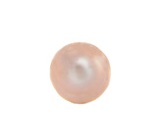 |
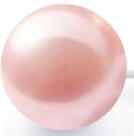 |
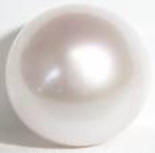 |
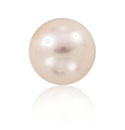 |
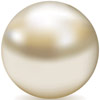 |
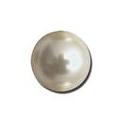 |
II. Black Color
In this classification fall not only the truly black pearls, but dark grey specimens as well. Also classed under Black are bronze, dark blue, purple, blue-green and green pearls with a pronounced metallic overtone. Those having a black body and a metallic green overtone are the most desirable. An intense, even color is essential in any black pearl; dingy (low intensity) colors are much less valuable.
III. Colored Pearls
Colored pearls are those that cannot be placed in either the Light or Black categories. They exhibit a pronounced hue as a body color, usually a light to medium tone of purple, yellow, grey, blue, Violet or green. Those colors are more common in Freshwater pearls than in those of salt water / sea origin.
Another type, in which the same body color does not extend uniformly over the surface, is called a two-color pearl. Even if one portion is very attractively colored, a round two-color pearl is less desirable for a necklace than one having a more usable overall color. Two-color pearls can be used to advantage in rings or other jewelry pieces, particularly when an unusual effect is desired, or they can be positioned so that only the more attractive sides show.
A third component of pearl color, and by far the most rate, is Orient. Orient is an iridescent sheen which moves on the surface of the pearl and resembles the play of color seen on a pinfire opal. Orient is caused by interference and diffraction of light among the tiny crystals comprising the layers of nacre and in order for a pearl to have a high degree of iridescence or orient it must have a reasonably thick coat composed of exceedingly thin and transparent nacre platelets.
Sources of Natural Pearl

By far the most important type of pearl is that produced by the salt water / sea "mollusc". The major, and almost the only important, source today is the Persian Gulf. Here the Pinctada Vulgaris and Pinctada Margaritifera are the pearl-producing molluscs, as they are for most salt water / sea pearls; the former is the largest pearl producer.
The fishing grounds (see shaded areas on accompanying map) are located in fairly shallow water around most of the shoreline, but particularly along the western side of the Gulf to the south and to the north of Bahrain Island. Pearl fishing is also accomplished in the southern and northern part of the Gulf. The oyster banks are at depths of four to eight fathoms (one fathom equals six feet). Since the Gulf is shallow over large areas, some banks are located sixty miles or more from shore.
There are hundreds of small fishing boats manned by about ten seamen and from one to a few divers. The diver carries a collecting bag, into which he places the oysters dislodged from the bottom, and a rope or cable to signal his desire to be pulled up .In deep water, weights and a nose clamp are used. Some divers have been known to stay down as long as four minutes, but one to two minutes is more common. If the owner of the boat is aboard, or if it is owned by the crew, the oysters are opened on deck: otherwise, the catch is taken ashore to be opened. The yield is-very low in terms of the number of molluscs recovered. Although it is subject to wide variation from bed to bed, only about one mollusc in forty contains a pearl, end-this in the important Persian Gulf fisheries.
After recovery, the pearls are purchased by Arab dealers, who take them to Bombay for sale to Indian merchants, (Up to this point, nothing has been done to the pearls except simple washing . They are much less attractive than they are in the state with which we are familiar, for organic materials still cling to them and some are slightly discolored by it.) In Bombay the pearls are bleached by immersing them in hydrogen peroxide and leaving them in the sunlight for hours. Following this they are sorted, graded and drilled. The poorest qualities are immediately separated for use in Oriental countries. Approximately 90% of the medium and fine qualities find their way to the pearl markets of Paris; of these, a significant proportion reach the United States.
Pearls from the Persian Gulf arrive in the United States via three main channels:
- sent directly from Bombay;
- purchased by agents in Bombay;
- sent to Paris or London consignment houses, or brokerage firms.
The brokers merely exhibit them to dealers, who inspect the merchandise and make offers. Offers are then transmitted to the Bombay owners, who either accept or reject them. Paris is a major center of purchasing and distribution of Oriental pearls, although many that are destined for the U.S. market are shipped directly from Bombay. Bombay remains, as in the past, mainly in brokerage, or commission center.
Minor pearl-producing regions include the Straits of Manaar, between Ceylon and India; the north, northwest and northeast coasts of Australia; Japan; Mexico; Panama; Venezuela; and the South Sea Islands, including Tahiti. It is interesting to note that Venezuelan pearls are fished off the coast of Margarita Island, which, as mentioned previously, is the Greek word for pearl. Fresh water pearls are found in the United States, principally in the tributaries of the Mississippi, as well as in Scotland, China and almost any fairly large river in a temperate climate. Florida and the West Indies are sources of "conch pearls."
Trade Names and Types of Natural Pearls

Although a wide quality range is typical of any of the major pearl fishing areas, the majority of pearls from any given area possess characteristics, principally of color, that are peculiar to that area. For this reason, it has been a common practice for many dealers to use locality names to refer to pearls possessing characteristics common to that locality, even though the pearls may have originated elsewhere. This procedure has its limitations, however. Following is list of the locality names that have been used in the trade, together with the characteristics and geographical implications included under such names.
-
Oriental pearls
American pearls dealers have used this term to describe only those natural pearls fished from the Persian Gulf. However, it has been the more general trade custom to class all salt water natural pearls as Oriental. Under such a classification, all the grades mentioned below, as well as pearls fished from minor sources, have been called Oriental. Because of the broad interpretation of the term "Oriental" and the resultant confusion to both laymen and members of the trade, the Federal Trade Commission considers it an unfair trade practice to use it to describe natural pearls not found in salt water/ sea molluscs of the Persian Gulf or cultured pearls or imitation pearls. Ceylon, or Madras Pearls
Those that have fancy overtones of blue, green or purple on a white or light cream body color.-
Tahiti or Island Pearls
White pearls with only a slight overtone. Yellow, grey and blackish pearls of a distinctive appearance are also found off Tahiti and other South Sea islands. A slightly greyish, metallic cast is also characteristic of pearls from this source. -
Venezuela Pearls
These are very white or yellow and more transparent than pearls from Oriental sources. A greenish overtone is common. Very few reach the market at present, since most are used locally. -
Australian Pearls
These are very white and have little or no overtone. Some have more luster than others and are described as "slivery". Pearls from other sources with a similar appearance are often classed as Australian pearls. -
La Paz, or Panama Pearls
Pearls described by these terms are usually black, greyish or yellow. Occasionally, however, pearls suitable for matching with others are found, and they may have an appearance almost equal to that of Persian Gulf pearls. -
Fresh Water, or American Pearls
These usually have strong colors and may have high luster and orient(iridescence). Fancy colors are quite common. -
Other Trade Names
"Blue pearl" and "mud pearl" are terms applied to those that have a nucleus of mud or impure crystalline calcite or aragonite. "Maiden pearl" is a fanciful term applied to newly fished pearls. "French pearl" is a misnomer, since it is merely an irregular piece of shell, usually cut from that portion of the valve near the hinge.
Shapes of Pearls

- Round As spherical as possible is the most
desirable.
- Pear Shaped Smoothly shaped, with one end smaller than the other.
- Egg Shaped Smoothly oval shaped.
- Drop Shaped A smooth tear drop shape.
- Button Shaped More or less spherical on one side, a some what flattened on the back.
- Baroque Shaped
Refers to all irregular shapes; i.e. any except round, pear,
eag, drop or button shapes. - Slugs Baroque pearls with poor luster.
- Half Pearls The trade term for pearls cut to produce a hemispherical or domed shape with a flat aside. It is actually one-half of a round pearl.
- Three Quarter Pearls Similar to a half-pearl, except that it is three-fourths round with a flat cut side.
- Seed Pearls This term usually refers to all pearls of less than one-fourth of a grain in weight. They are usually unsymmetrical.
- Dust Pearls Unsymmetrical pearls that are too small to be useful for jewelry purposes.
- Blister Pearls These were originally attached to the shell; therefore, they cannot be classed as true pearls. They are usually irregular or flattened and sometimes contain clay or water or even a true pearl, which was not originally attached to the shell. They occur in most pearl-bearing molluscs.
Physical & Optical Properties of Pearl

Physical Properties |
|||||||||||
| Chemical Composition |
|
||||||||||
| Crystallographic Character | An aggregate composed largely of minute orthorhombic crystals of aragonite and some times hexagonal calcite crystals. Conchiolin, the cementing material, is non crystalline. | ||||||||||
| Hardness | 2½ to 4 | ||||||||||
| Toughness | Usually, good, but variable. Many pearls are quite tough, but toughness is not constant and care must be exercised in handling them. The outer surface layers may be fractured or scratched very easily. Toughness may also be affected by age, dehydration, or excessive bleaching when processed for the market. | ||||||||||
| Cleavage | None | ||||||||||
| Fracture | Uneven | ||||||||||
| Specific Gravity | Oriental salt water natural pearls average
between 2.66 and 2.76. Some Australian pearls are as high as 2.78. Gulf of Mexico pearls vary from 2.61 to 2 .69. Fresh-water natural pearls have a density of about 2.66 to 2.78, but few are over 2.74. Inferior pearls are often much lighter. The S.G. of "conch pearls" is near 2.85. |
||||||||||
| Streak | White. | ||||||||||
Optical Properties |
|
| Degree of Transparency | Translucent to opaque |
| Luster | Various from dull to almost metallic, depending on the nature of the layers and their degree of transparency. Fracture surfaces are pearly to dull. |
| Refractive Index | 1.53 - 1.69. Because of the curved surfaces of pearls, approximate R.I. and birefringence can be detected only by the spot method. |
| Birefringence | 0.156 |
| Optic Character | Doubly refractive |
| Pleochroism | None |
| Dispersion | None |
| Phenomena | Orient. Varies from none to very pronounced. |
| X-Ray, Fluorescence | Salt-water natural pearls are inert, with the exception of some very white pearls from Australian waters which fluoresce faintly. The majority of fresh-water natural pearls fluorescence a moderate to strong yellowish white. |
| Transparency to X-Rays | Semitransparent |
| Ultraviolet Fluorescence | None to strong light blue, yellowish, greenish or pinkish under both short and long wavelengths . Natural color black natural pearls show a fluorescence ranging from light pink to cherry to brick red under long-wave. |
| Color-Filler Reaction | None |
| Absorption Spectra | Varies widely; no diagnostic value. |
Effects Caused by: |
|
| Heat | Excessive heat, such as an open flame, may cause pearls to be burned, turn brown, or split or crack. Even moderate heat over a period of time can cause dehydration, which in turn can cause the nacre to crack. |
| Acids | Attacked violently by all acids. Acid skin perspiration or perfume also will attack nacre |
| Irradiation | Darkens color. |
Care of Pearls

Heat, perfume, excessive perspiration, face powder, hair sprays, skin oils, or constant contact with hard, rough-textured fabrics may damage the delicate outer surface of pearls. Wearing pearls so they come in contact with other jewelry will cause them to become scratched and worn. Pearls should be strung with knots between them, otherwise, the friction caused by the pearls coming into contact with one another will cause wear at the drill holes. In addition, if the string is broken, the knots will prevent the loss of more than one pearl. Care must be exercised in repairing pearl jewelry, because heat may split pearls and turn them brown and acids will attack them violently. Although many pearls retain their beauty in full measure for centuries, they are subject to a gradual loss of water from the organic conchiolin binding agent. The greater the amount of conchiolin in a pearl, the more rapidly it will show evidence of deterioration through dehydration. It may take generations for yellowing, surface cracking or other signs to become evident, however. If properly cared for, natural pearls should last for many lifetimes. Constant contact with perfume or acid skin secretions is much more damaging than the ravages of time. Pearls should be cleaned by immersion in a mild non—detergent soapy solution, nothing stronger. Do not clean pearl jewelry in ultrasonic cleaners. The lightly acid solution used in these cleaners may attack the nacre and the vibrations may cause further damage to pearls with internal or external cracks.
Valuation of Natural Pearl

The factors that affect the value of natural pearls are as follows :
Color
A pure and even color is essential; "muddy", dull or dingy colors are much less valuable. As described previously, the color of a fine pearl includes body color, overtone(s) and / or orient.-
Luster
A very high luster of even intensity is absolutely essential in a pearly of fine quality. Such pearls often have very thin, transparent nacreous layers. -
Degree of Translucency
The most valuable pearls are semi translucent. Pearls lacking translucency, although of the same color, will appear blackish or dense when compared with others in a necklace, especially in artificial light. -
Texture
Although a blemish free natural pearl is rare, value is affected by the presence of cracks, scratches, dents, bumps, and uneven surface, white spots or other discolorations. A broken surface or graduations caused by polishing away slight bumps also lowers the value. Comparative value also is affected by the position of the blemishes and the extent to which they affect beauty. Pearls with decided surface cracks are almost worthless. -
Shape
An ideal pearl would be perfectly spherical, as though turned out by machine. Perfection in any natural thing is rare, however, because of uneven color, translucency or luster, some almost spherical pearls may appear off shape, thus lowering their value somewhat. Button, pear or drop shapes, if symmetrical and of fine quality, are frequently very valuable. -
Size
Size is an important factor in determining the value of a pearl. As will be explained later, the quality of a natural pearl is first considered to establish a base rate and this is multiplied by the square of the weight; therefore, each increase in size has a profound effect on price. Large pearls that meet all of the high quality requirements listed above are exceedingly rare and all but priceless. Other factors that affect value follow. -
Matching and Blending
The value of a necklace depends not only on the quality of the pearls but also on how they are matched or blended. Matching implies pearls of exactly the same color; blending indicates the use of very similar tones or tints of the same color that are apparent when the pearls are placed side by side. How well the pearls in a necklace are matched for size and shape, as well as the accuracy of graduation in a graduated strand, also have a marked effect on value. The preparation of a well blended or well matched necklace requires time, care and patience in the meticulous grading of many pearls. Since such a strand is much more desirable, it is much more valuable than one that is poorly blended or matched. -
Artificial Treatment
Surface cracks or the subsurface layers may be filled with a colored solution; this is most often used to produce dyed black pearls. Also, slight surface or under skin cracks often can be temporarily "healed" by the use of Canada balsam. Broken outer skins can sometimes be repaired, but only by the most skillful experts. It must be remembered that the nacreous portion of a pearl does not consist of solid concentric layers but of minute, overlapping, plate like crystals, similar to the shingles on a roof. "Peeling" a pearl (i.e., grinding or scraping away undesirable areas) has become a rather common expression; however, it is a very risky practice, because the under layers may be dull, spotted and worthless. Dents in the surface have been known to continue and even multiply as the work progresses. Off-shaped pearls may be made round by removing objectionable portions, but such pearls are seldom increased in value. -
Drilling
Large or unevenly drilled holes can affect value materially. A drill hole just sufficiently large to accommodate a suitable silk or nylon thread is the most desirable. Pearls that have very large drill holes, caused by either long wear or improper drilling originally, are often plugged with a piece of metal or mother-of-pearl and re-drilled with a smaller hole.
Natural pearl appraisal is even more complicated than diamond evaluation. Most retailers handle too few strands of natural pearls to justify obtaining the lengthy training and experience that is necessary to appraise accurately. The rarity of pearls increases even more rapidly with increasing size than diamonds. In addition, a matched pair of pearls is worth much more in the pearl trade than the two pearls before matching. To take such complicated relationships into account, pearl importers use a system based on what they call the "once" of a pearl or group of pearls, which considers size and a base rate covering the quality of the pearls and matching, if any, since this system is rarely, if ever, used by the retailer, it will be discussed briefly by citing example of its use. The price of a single natural pearl is computed by squaring its weight in grains and multiplying the result by the base rate. The quality of a single pearl determines the base rate. For example, if a pearl weighs 8.65 grains and the base rate is $6, 8.65 x 8.65 x 6 = $449 APP.
